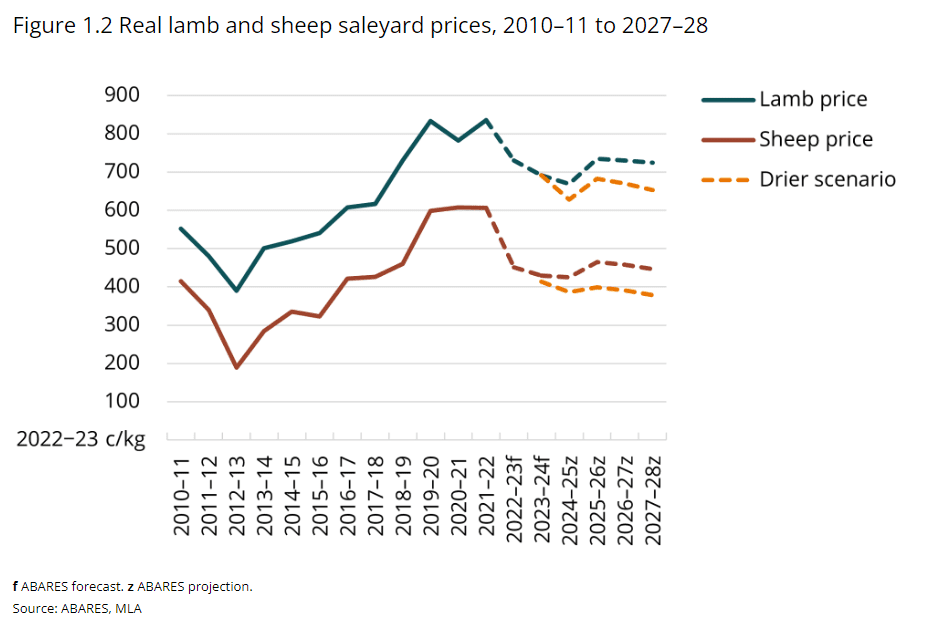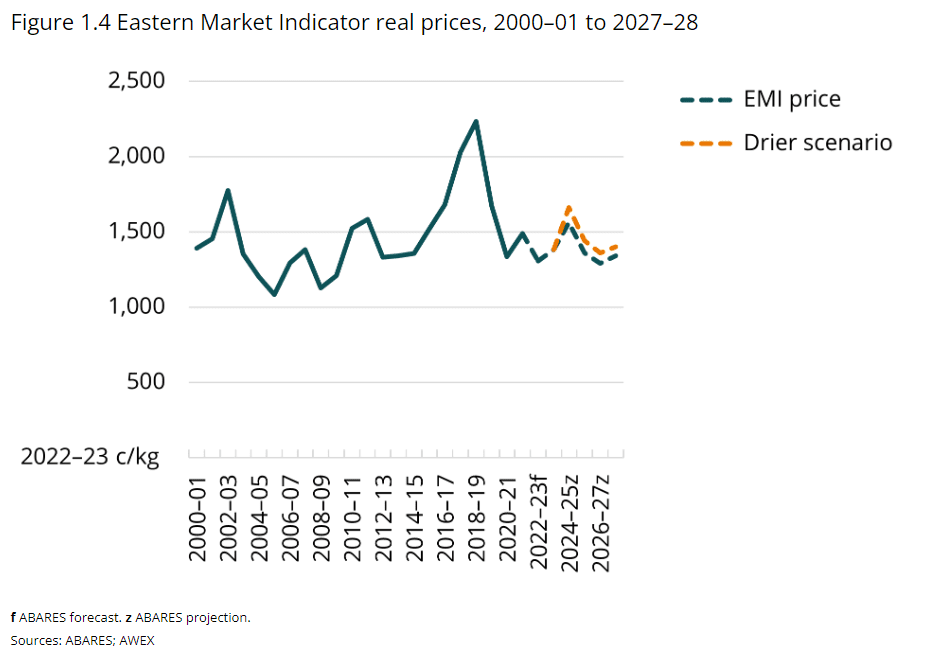SALEYARD lamb and sheep prices are expected to fall in 2022-23 due to increased supply and weaker consumer demand, but would rise in the medium term, according to the latest ABARES commodities outlook.
And ABARES expected the benchmark Eastern Market Indicator for wool to increase 11 percent to 1443 cents per kilogram in 2023–24 and higher in a drier weather scenario.
The sheep, lamb and wool price forecasts come as the gross value of agricultural production in Australia is expected to reach $90 million in 2022-23 despite flood impacts, largely as a result of gains in cropping.
Farm cash income for all broadacre farms is projected to decrease nationally by around 7pc to average $327,000 per farm in 2022-23 but remain 46pc above the 10-year average.
Flock rebuild is starting to impact

ABARES today said flock rebuilding has increased the supply of sheep and lambs available for slaughter and has put downward pressure on prices.
By 2023-24, ABARES expects lamb saleyard prices are forecast to decrease to a national trade lamb indicator level of 691c/kg. Sheep saleyard prices are forecast to fall to 430c/kg due to increased supply of older sheep. Under a drier weather scenario, these prices could be lower.
ABARES said export demand in the United States for sheep meat is expected to weaken due to subdued economic growth and prices for restocker lambs are expected to decline due to less favourable seasonal conditions. Reduced pasture growth is expected to dampen demand for restocker lambs due to less feed availability.
However, ABARES said lower prices are expected to support Australia’s international competitiveness. In its drier weather scenario, prices are expected to be lower due to lower global demand and drier seasonal conditions prompting higher turnoff.
Live export numbers to decrease
ABARES expected live sheep exports to increase by 6 percent in 2022-23 to around 520,000 head due to increased demand in the Middle East. Hopwever, from 2023-24, live sheep exports are expected to weaken due to subdued economic growth and less available sheep in Western Australia, in line with the long-term decline of live sheep export volumes and the long-term decline of the flock in Western Australia.
“Over the medium term to 2027-28, live sheep exports are expected to continue their long-term decline due to reduced availability of sheep in Western Australia.
“Regulations and seasonal restrictions will continue to limit the number of exports of live sheep,” ABARES said.
Macroeconomic conditions to increase wool demand

ABARES said improved macroeconomic conditions in advanced economies are expected to increase demand for woollen garments lifting domestic wool prices. This is expected to be only partially offset by Australian production volumes increasing.
“Continued strong economic growth in 2024-25 and a contraction in Australian wool production is projected to lift wool prices 13pc to 1560 cents per kilogram (in real terms).
“Wool prices will shift over the remaining years according to demand conditions, driven by macroeconomic factors, and the supply of fine wool, driven by seasonal conditions.
In 2027–28, ABARES has projected the EMI to be 1340 cents per kilogram.
“In the drier scenario, drier conditions across Australia would reduce the global supply of fine wool, putting upward pressure on prices.
“Dry conditions and reduced production, along with strong economic growth in 2024–25 would see prices increase 20% to 1,660 cents per kilogram,” ABARES said.
“In 2027–28, wool prices would be expected to average 1400 cents per kilogram.”
ABARES executive director Dr Jared Greenville said record gross value of agricultural production is expected in 2022-23 despite the floods across eastern Australia.
“Australia is benefitting from a third consecutive year of high rainfall, and it shows in the figures.
“Once again, we’re seeing record levels of production, driven by exceptional growing conditions and high commodity prices,” he said.
“The value of production when we include fisheries and forestry, is $96 billion.”
Dr Greenville said agricultural exports are also forecast to set new records, reaching $75 billion in 2022–23.
“This is the first time we’ve seen our exports exceed $70 billion, which is a huge achievement.
“National winter crop production has driven much of these results, with the winter crop estimated at a new record of 67.3 million tonnes in 2022–23.”
He said production of wheat and canola are estimated to have reached new records, and the third highest barley production on record is expected.
“High values of livestock production have also contributed to these record numbers, with producers increasing their production while also benefitting from historically high prices.”
Dr Greenville said this year will likely be the last hurrah for the La Nina rain system for a while, and we can expect drier seasonal conditions ahead.
“However, production will continue to be supported by good soil moisture and high water storage levels.
“While we expect production to be lower in 2023-24, at $81 billion it will still be the third highest on record.”
ABARES head of farm performance, Peter Gooday, said incomes for broadacre farms are expected to decrease in all states except Western Australia and South Australia in 2022-23, with incomes in New South Wales, Queensland and Victoria impacted by heavy rainfall and flooding during the year.
“Good seasonal conditions and higher commodity prices have been major drivers of improved broadacre farm performance in Australia in recent years.
“However, farm incomes are projected to fall slightly in 2022-23 because of lower prices for most commodities and input costs remaining high after significant increases in 2021-22.”
The most recent Agricultural Commodities Report can be read here: https://www.agriculture.gov.au/abares/research-topics/agricultural-outlook.
The Australian Crop Report can be read here: https://www.agriculture.gov.au/abares/research-topics/agricultural-outlook/australian-crop-report.
Source: ABARES.



HAVE YOUR SAY